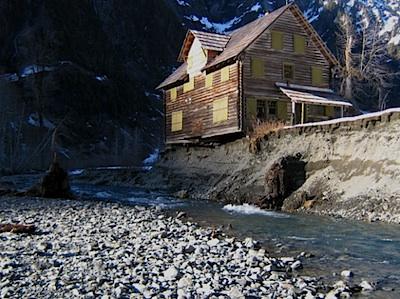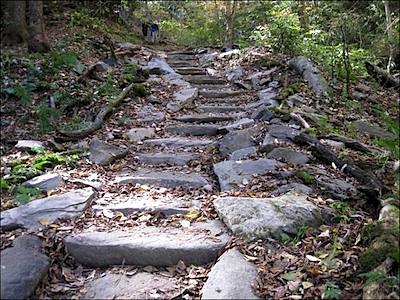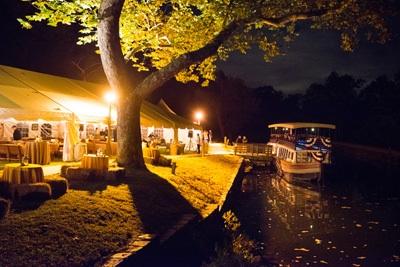
Crews have moved the Enchanted Valley Chalet away from the East Fork Quinault River/NPS
Take a look around the National Park System and you'll see historic buildings being moved, citizen science at work, and a wonderful evening gathering around a historical park.
Olympic National Park's Enchanted Valley Chalet Moved
In a relatively quick move, crews were able last week to complete the relocation of the Enchanted Valley Chalet away from the East Fork Quinault River, which was slowly gnawing away at the ground beneath this historic log structure. Work to temporarily relocate the chalet was completed on Friday, September 12.
'I am very proud of our park staff, and appreciative of the contractor and his work,' said Olympic Superintendent Sarah Creachbaum. 'We are very pleased to know that the chalet is now further from the river.'
Work to temporarily relocate the chalet began September 1. Contractor Monroe House Moving of Sequim, Washington, used hydraulic jacks to push the structure 100 feet along steel beams and away from the eroding river bank. Once the move was complete, the building was lowered onto cribbing towers and secured. The building will remain closed to the public while in its current temporary location.
A planning and environmental analysis process will begin within the next year to determine the final disposition of the building.
The Enchanted Valley Chalet is located 13 miles from the nearest road, deep within the Olympic Wilderness. The chalet was constructed by Quinault Valley residents in the early 1930s, prior to establishment of Olympic National Park. The chalet served for several decades as a backcountry lodge and more recently, as a wilderness ranger station and emergency shelter. The chalet was added to the National Register of Historic Places in 2007.
Photos shared by park visitors in early January showed that the main channel of the East Fork Quinault River had migrated to within 18 inches of the 1930s-era chalet. Last winter's storms and high flows resulted in the Quinault's main channel continuing to shift by at least 15 feet. Recent photographs showed that the river had undercut the building by approximately eight feet.
Work Timeable For Chimney Tops Trail In Great Smoky Mountains National Park Extended
Great Smoky Mountains National Park officials have extended the Chimney Tops Trail closure through December 11 to fully complete the 3-year trail rehabilitation. The trail will continue to be closed each Monday through Thursday as workers complete the full-scale rehabilitation. The trail is open Friday through Sunday each week, offering hikers a unique opportunity to see improvements taking shape along the trail.

It's taking longer than expected to complete work on restoring the Chimney Tops Trail in Great Smoky Mountains National Park/Friends of the Smokies
"We appreciate the patience and support of hikers during the restoration of Chimney Tops Trail," said acting-Superintendent Clay Jordan. "The highly-skilled Trails Forever crew, along with volunteers, have accomplished an amazing feat by turning a heavily eroded trail into a durable trail that will better protect delicate trailside resources and serve visitors well into the future."
The combination of heavy use, abundant rainfall, and steep terrain turned the Chimney Tops Trail into a badly eroded obstacle course of slick, broken rock, exposed tree roots, and mud. Since April 2012, The park's Trails Forever Crew has been rebuilding the trail using durable stone and rot-resistant black locust timbers that will stabilize the trail for decades to come, reducing annual maintenance and greatly improving the visitor experience.
Trails Forever is a partnership program between Great Smoky Mountains National Park, the Friends of the Smokies who donated $500,000 to carry out the project on Chimney Tops Trail, and the generosity of the Knoxville based Aslan Foundation.
Check Out The Park After Dark At Chesapeake & Ohio Canal National Historical Park
Park After Dark is the only event of its kind to be held within the grounds of the C&O Canal National Historical Park. Guests will enjoy the natural splendor of the Great Falls area and the historic Tavern, while learning more about the Trust and the Canal itself.
This year, the friends group will be celebrating the 60th anniversary of Supreme Court Justice William O. Douglas's walk that helped to preserve the Canal. Lively music by Trouble Brewin', hearty chili with delicious accompaniments, delectable desserts, unique auction items, a visit from the Canal's mules, and a roaring bonfire will punctuate the evening.

It's not too late to get a ticket for the Park After Dark fundraiser for the C&O Canal Trust/Canal Trust
The evening's highlight will be the presentation of the Trust's 2014 William O. Douglas Stewardship Award to Richard E. Marriott, Chairman of the J. Willard and Alice S. Marriott Foundation.
Tickets are $175 a person; $125 of that amount is a tax-deductible donation to the C&O Canal Trust.
Trust For The National Mall Adds Two New Board Members
The Trust for the National Mall, the official nonprofit partner of the National Park Service dedicated to restoring and improving the National Mall, announced that John Drew, president and chief executive officer of Trade Center Management Associates LLC, and Todd Walker, vice president of federal government affairs and government affairs programs of Altria Client Services, have been named to the Trust's Board of Directors.
The board serves an invaluable leadership role in the Trust's efforts by guiding and advancing the Campaign for the National Mall, which is raising the vital funds to restore and preserve America's front yard for generations to come. As members of the board, Drew and Walker will help ensure the Trust is managed well, promote its mission, and oversee the strategic direction of the organization.
'We are delighted to welcome such tremendous leaders as our newest board members,' said Caroline Cunningham, president of the Trust for the National Mall. 'Their professional experience and enthusiasm for our cause provide added momentum for the Campaign for the National Mall as we advance our fundraising and awareness efforts in 2015 and beyond.'
John P. Drew became president and chief executive officer in 2003 of Trade Center Management Associates, which manages, leases and operates the 3.1-million-square-foot Ronald Reagan Building and International Trade Center in Washington, D.C. That same year he also was named vice president of The Drew Company, an innovative, Boston-based real estate management and development company. Drew is also a board member at Destination DC and serves as the director of the World Trade Center Dublin. He is a graduate of Boston College and the Michael Smurfit Graduate Business School of the University of Dublin.
Todd A. Walker is the vice president of Federal Government Affairs and Government Affairs Programs for Altria Client Services, which provides professional services and support to Altria Group and its operating companies. Todd brings to the Trust an extensive background in government affairs, having spent more than 20 years leading government affairs functions at Altria and UST Inc., where he served as vice president of Government Relations and Public Policy. He also serves on the Louisa M. Swain Foundation Board of Directors.
Drew and Walker are enhancing an 18-member board committed to advancing the Campaign for the National Mall and articulating the value of the National Mall as a symbol of our nation's pride and history.
Citizen Scientists Helping Shenandoah National Park Staff Monitor Mercury Contamination
Shenandoah National Park has joined in a nation-wide study to sample mercury levels in national parks in an effort to identify threats to natural resources. This national project engages local citizen scientists to collect dragonfly larvae from distinct sampling sites in order to allow for comparison between parks and to provide baseline data on the spatial distribution of mercury contamination in national parks. To date, more than 300 citizen scientists have contributed more than 1,800 hours towards the National Park Service-wide study.
In late August, Shenandoah staff was joined by local volunteers and researchers from the University of Virginia to collect data on the mercury levels in dragonfly larvae at Piney River in the park's north district and Staunton River in the park's central district. The University of Maine will analyze the samples and results will be compared to data from participating NPS units across the nation. Other project partners include the U.S. Geological Survey, The Schoodic Institute, and the NPS Air Resources Division.
'Researchers are still trying to understand the fundamental drivers of mercury deposition and transport, and the Shenandoah National Park is the ideal place to do this. In this higher elevation, atmospheric mercury can be stored in the soils and potentially be a long-term source of mercury to downstream environments," said Dr. Ami Riscassi of the University of Virginia. "Here at the top of the watershed, we are the first stop to understanding how changes in atmospheric mercury are going to affect water resources at the park and downstream.'
The sampling procedure involves collecting dragonfly larvae from the bottom of rivers or lakes with nets. As dragonflies spend up to five years of their lives in larval form, they have years to eat and accumulate mercury as they grow and develop. Dragonflies are predators that eat a lot of other insects, placing them relatively high in the food chain. For these reasons, dragonfly larvae build up higher levels of mercury than other water-dwelling insects.
Dragonfly larvae is a food source for many types of fish that then accumulate more mercury, and are then in-turn consumed by mammals, birds, and humans, posing an even greater threat to health. Because larvae are much easier to sample than fish, they provide an excellent source of information on the levels of mercury contamination in an area.
Mercury contamination in a remote national park environment often comes from atmospheric deposits from coal-burning power plants. Studying dragonfly larvae in Shenandoah National Park is an important first step in understanding the extent of mercury contamination in this portion of the Blue Ridge and how it compares to contamination in other national parks.
'Many thanks to all our local and national partners for getting this program started at Shenandoah National Park!' said Jalyn Cummings, air & water program manager at Shenandoah. 'I'm hoping this will be just the first in many years of mercury monitoring for Shenandoah.'



Add comment